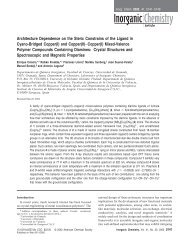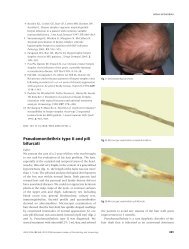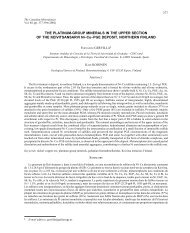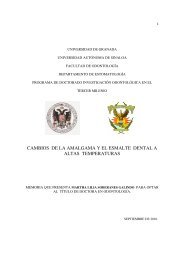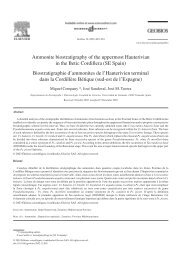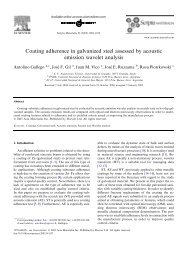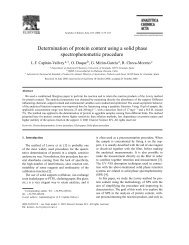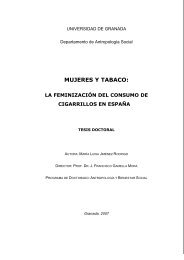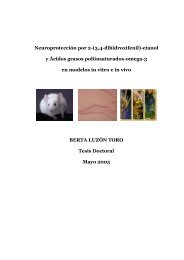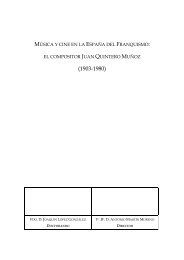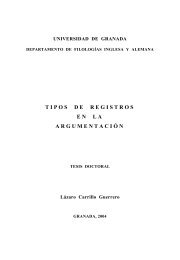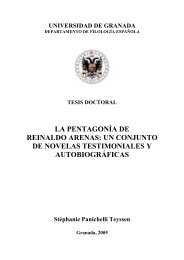40 J.E. Caracuel et al. / Geobios 39 (2006) 25–42 Fig. 7. Syn<strong>the</strong>tic <strong>Jurassic</strong> successions at Sierra Espuña, with indication <strong>of</strong> bi<strong>of</strong>acies, micr<strong>of</strong>acies <strong>and</strong> <strong>paleoenvironmental</strong> interpretation for <strong>the</strong> main lith<strong>of</strong>acies. M (mudstones), W (wackestones), P (packstones), G (grainstones). Legend for bioclasts in Fig. 2. Fig. 7. Succession synthétique du Jurassique de la Sierra Espuña, avec indication des bi<strong>of</strong>aciès, micr<strong>of</strong>aciès et interprétation paléoenvironnementale du lith<strong>of</strong>aciès principal. M (mudstones), W (wackestones), P (packstones), G (grainstones). Légende des bioclastes Fig. 2. inner moulds, mostly reworked; frequent loss <strong>of</strong> bodychambers <strong>and</strong> truncations incompatible with <strong>the</strong> stratification. In <strong>the</strong> nodular-brecciate facies, inner moulds <strong>of</strong> ammonites are <strong>of</strong>ten fragmented <strong>and</strong> imbricate. Finally, at <strong>the</strong> end <strong>of</strong> <strong>the</strong> <strong>Jurassic</strong> <strong>the</strong> generalized <strong>the</strong>rmal subsidence tends to deepen <strong>the</strong> paleomargin, while <strong>the</strong> huge relief caused by <strong>the</strong> horst <strong>and</strong> graben system is smoo<strong>the</strong>d. Consequently, <strong>the</strong> area evolved to a basin in Lower Berriasian (probably already from <strong>the</strong> uppermost Tithonian) with deposition <strong>of</strong> periplatform limestones toge<strong>the</strong>r with <strong>the</strong> local sedimentation by planktonic micr<strong>of</strong>ossils (calpionellids, foraminifers, radiolarians, as well as algae). 7. Conclusions A multidisciplinary study has enabled greater precision in updating <strong>the</strong> biostratigraphic framework <strong>and</strong> <strong>the</strong> <strong>paleoenvironmental</strong> interpretation <strong>of</strong> <strong>the</strong> <strong>Jurassic</strong> succession at Sierra Espuña. This area, which is one <strong>of</strong> <strong>the</strong> bigger, better exposed <strong>and</strong> more fossiliferous <strong>Jurassic</strong> outcrops <strong>of</strong> <strong>the</strong> Malaguide domain, can be considered a clue area to analyze <strong>the</strong> <strong>evolution</strong> <strong>of</strong> <strong>the</strong> Internal Zones <strong>of</strong> <strong>the</strong> Betic Cordillera. As a whole, ammonite biostratigraphic data from <strong>the</strong> Internal Zones are scanty, <strong>and</strong> related only to <strong>the</strong> “Dorsal” <strong>and</strong> Malaguide domain such as <strong>the</strong> Sierra Espuña area. Particularly for this area, <strong>the</strong> previous biostratigraphic data, which comes from <strong>the</strong> 1960s <strong>and</strong> 1970s, need to be updated <strong>and</strong> revised. Thus, three previously studied <strong>and</strong> two new <strong>Jurassic</strong> sections at Sierra Espuña were sampled, leading to a more precise biostratigraphic ammonite framework. Ammonite assemblages have enabled <strong>the</strong> recognition <strong>of</strong> <strong>the</strong> Domerian, Lavinianum (Cornacaldense Subzone), Algovianum (Ragazzoni, Bertr<strong>and</strong>i, Accuratum <strong>and</strong> Levidorsatum Subzones) <strong>and</strong> Emaciatum (Solare <strong>and</strong> Elisa Subzones) Zones, <strong>the</strong> Lower Toarcian, Polymorphum <strong>and</strong> Serpentinum Zones, <strong>the</strong> Middle Toarcian, Bifrons <strong>and</strong> Gradata Zones, <strong>the</strong> Upper Toarcian, Reynesi Zone, <strong>the</strong> uppermost Lower/Upper Bajocian, <strong>the</strong> Lower Callovian (Bullatus <strong>and</strong> Gracilis Zones), <strong>the</strong> Middle <strong>and</strong> Upper Oxfordian (Transversarium, Bifurcatus, Bimammatum <strong>and</strong> Planula Zones) <strong>and</strong> <strong>the</strong> Lower <strong>and</strong> Upper Kimmeridgian (Platynota, Strombecki, Divisum <strong>and</strong> Beckeri Zones). Some <strong>of</strong> <strong>the</strong>se zones <strong>and</strong> subzones are recognized, or documented with reported faunas, for <strong>the</strong> first time. As a whole, benthic assemblages dominated during <strong>the</strong> Lower <strong>Jurassic</strong>, while benthonic/planktonic assemblages
developed within <strong>the</strong> Middle–Upper <strong>Jurassic</strong>. Ammonite taphonomy reveals <strong>the</strong> abundance <strong>of</strong> reworked assemblages with common truncation, imbrication <strong>and</strong> coating (by Fe–Mn oxides) <strong>of</strong> inner moulds or shells. Never<strong>the</strong>less, only occasionally during <strong>the</strong> Domerian–Lower Toarcian interval <strong>of</strong> alternating yellowish marly/silty limestones <strong>the</strong> faunal condensation mixed biostratigraphically recognizable horizons. The assemblages <strong>of</strong> ammonite faunas analyzed from <strong>the</strong> Domerian to <strong>the</strong> Kimmeridgian show a Mediterranean character. Thus, <strong>the</strong> bio-chronostratigraphic zonal/subzonal scheme was applied, with minimal changes, for Mediterranean Province (Cariou <strong>and</strong> Hantzpergue, 1997). The interpreted <strong>paleoenvironmental</strong> <strong>evolution</strong> <strong>of</strong> <strong>the</strong> <strong>Jurassic</strong> Malaguide at Sierra Espuña appears to be similar, <strong>and</strong> comparable in timing, to o<strong>the</strong>r perimediterranean Tethyan paleomargins. It evolves as a passive margin, with development <strong>of</strong> shallow carbonate platform, until <strong>the</strong> Domerian (Lavinianum Zone), when <strong>the</strong> platform break-up took place, starting <strong>the</strong> rifting stage. During this stage in <strong>the</strong> Dogger, <strong>the</strong> horst–graven system begins <strong>and</strong> <strong>the</strong> area was drowned at considerable depth. Then, from <strong>the</strong> Lower Callovian to <strong>the</strong> Middle Oxfordian, <strong>the</strong> drifting stage started, emphasizing <strong>the</strong> horst– graven system with development <strong>of</strong> condensed nodular limestones in <strong>the</strong> raised sea-floor. Acknowledgements This research was economically co-financed by <strong>the</strong> research Projects BTE2001-3020, BTE2001-3029, BTE2000- 0299 <strong>and</strong> BTE2003-01113 (Spanish Ministry <strong>of</strong> Science <strong>and</strong> Technology) <strong>and</strong> Research Groups GR00-222, GV04B-629 (Generalitat Valenciana) <strong>and</strong> RNM-178 (Junta de Andalucía). We are grateful to Pr<strong>of</strong>essor A. Jiménez (University <strong>of</strong> Granada) for Photograph assistance. We are also indebted to Mr. D. Nesbitt for <strong>the</strong> revision <strong>of</strong> <strong>the</strong> English text. References Azema, J., 1960. Sur la stratigraphie du Jurassique des environs de Málaga (Espagne). Comptes Rendus de l’Académie de Sciences de Paris 250, 2231–2233. Azema, J., 1961. Étude géologique des abords de Málaga. Estudios Geológicos 17, 131–160. Braga, J.C., 1983. Ammonites del Domeriense de la Zona Subbética (Cordilleras Béticas, Sur de España). Tesis doctoral. Secretariado de Publicaciones, Universidad de Granada. Caracuel, J.E., S<strong>and</strong>oval, J., Martín-Martín, M., Estévez, A., Martín- Rojas, I., 2001. Datos preliminares del Jurásico del perfil de Malvariche en Sierra Espuña (Complejo Maláguide; Zonas Internas Béticas). XVII Jornadas de Sociedad Española de Paleontología, 271–278. Cariou, E., 1980. L’étage Callovien dans le Centre-Ouest de la France. Thèse de Doctorat ès-Sciences, Université de Poitiers. Cariou, E., Hantzpergue, P., 1997. Groupe Français d’Études du Jurassique, biostratigraphie du Jurassique ouest-européen et méditerranéen. Zonations parallèles et distribution des invertébrés et micr<strong>of</strong>ossiles. Bulletin des Centres de Recherches-Exploration Production d’Elf-Aquitaine 17, 1–400. J.E. Caracuel et al. / Geobios 39 (2006) 25–42 Catalano, R., Lo Cicero, G., Sullo, A., 2002. Geology <strong>of</strong> Sicily: An Introduction. In: Santantonio, M. (Ed.), General Field Trip Guidebook. VI International Symposium <strong>Jurassic</strong> Stratigraphy (12–22 Septiembre 2002). Palermo, Sicily, pp. 1–320. Colacicchi, R., Parisi, G., Zamparelli, V., 1999. Bioevents <strong>and</strong> integrated <strong>biostratigraphy</strong> <strong>of</strong> <strong>the</strong> Triassic <strong>and</strong> <strong>Jurassic</strong> in Italy. Palaeopelagos, Special Publication 3, 1–184. Doyle, P., MacDonald, D.I.M., 1993. Belemnites Battlefields. Lethaia 26, 65–80. Fallot, P., 1929. Esquisse géologique du Massif de la Sierra Espuña (Prov. de Murcia). Boletín de la Real Sociedad Española de Historia Natural 29, 199–215. Fallot, P., 1931–1934. Essais sur la répartition des terrains secondaires et tertiaires dans le domaine des Alpides espagnoles (Lias, Dogger, Jurassique supérieur). Géologie de la Méditerranée occidentale 4, 1–118. Fallot, P., 1945. Estudios geológicos en la Zona Subbética entre Alicante y el río Guadiana Menor. Monografías del Consejo Superior de Investigaciones Científicas, Instituto Investigaciones Geológicas “. Lucas Mallada 5, 1–719. Fernández-López, S.R., 2000. Temas de Tafonomía. Departamento de Paleontología, Universidad Madrid. Geel, T., 1973. The Geology <strong>of</strong> <strong>the</strong> Betic <strong>of</strong> Málaga, <strong>the</strong> Subbetic, <strong>and</strong> <strong>the</strong> Zone between <strong>the</strong>se two units in <strong>the</strong> Vélez Rubio area (SE Spain). GUA Papers <strong>of</strong> Geology 5 (1), 1–179. Geyer, O.F., Hinkelbein, K., 1971. Eisenoolithische Kondensations- Horizonte im Lias der Sierra de Espuña (Provinz Murcia, Spanien). Neues Jahrbuch für Geologie und Paläontologie, Monatshefte 1971 (10), 398–414. Geyer, O.F., Hinkelbein, K., 1974. Las Oolitas ferruginosas del Jurásico de la Sierra de Espuña (prov. de Murcia). Acta Geológica Hispánica 9, 102–106. Guerrera, F., Martín-Algarra, A., Perrone, V., 1993. Late Oligocene–Miocene syn-/late-orogenic successions in Western <strong>and</strong> Central Mediterranean chains from Betic Cordillerra to Sou<strong>the</strong>rn Apennines. Terra Nova 5, 525–544. Kampchuur, W., Langerberg, C.W., Baena, J., Vel<strong>and</strong>o, F., García- Monzón, F., Paquet, J., Rondeel, H.E., 1974. Mapa y Memoria Explicativa del Mapa Geológico de España 1/50 000, Hoja de Coy (932). Instituto Geológico y Minero de España, 1–32. Maate, A., 1996. Estratigrafía y Evolución Paleogeográfica alpina del Dominio Gomáride (Rif Interno, Marruecos). PhD Thesys Universidad de Granada. Mac Gillavry, H.J., Geel, T., Roep, T.B., Soediono, H., 1963. Fur<strong>the</strong>r notes on <strong>the</strong> geology <strong>of</strong> <strong>the</strong> Betic <strong>of</strong> Málaga, <strong>the</strong> Subbetic, <strong>and</strong> <strong>the</strong> Zone Between <strong>the</strong>se two Units, in <strong>the</strong> Region <strong>of</strong> Vélez Rubio (Sou<strong>the</strong>rn Spain). Geologische Rundschau 53, 233–259. Martín-Martín, M., 1996. El Terciario del Dominio Malaguide en Sierra Espuña (Cordillera Bética oriental, SE España): Estratigrafía y Evolución Paleogeográfica. PhD Thesys Universidad de Granada. Martín-Martín, M., Martín-Algarra, A., 1997. La estructura del área de Sierra Espuña (Contacto Zonas Internas–Externas, sector oriental de la Cordillera Bética). Estudios Geológicos 53, 237–248. Martín-Rojas, I., Caracuel, J.E., Estévez, A., Martín-Martín, M., S<strong>and</strong>oval, J., 2002. <strong>Jurassic</strong> stratigraphy <strong>of</strong> <strong>the</strong> Malaguide Complex from Sierra Espuña (Internal Betic Zone, SE Spain). In: Gaillard, C., Hantzpergue, P. (Eds.), STRATI 2002, 3 e Congrès Français de Stratigraphie, Lyon 8-10 septembre 2002. Documents du Laboratoire de Géologie de Lyon 156, Lyon, pp. 156–157. Navarro, A., Trigueros, E., 1963. Estudio Geológico del Borde Oriental de la Sierra Espuña. Notas y Comunicaciones Instituto Geológico y Minero de España 70, 205–210. Paquet, J., 1962. Contribution à l’étude géologique de la Sierra Espuña (Prov. de Murcia, Espagne). Annales de la Société Géologique de Nord 32, 9–17. 41



